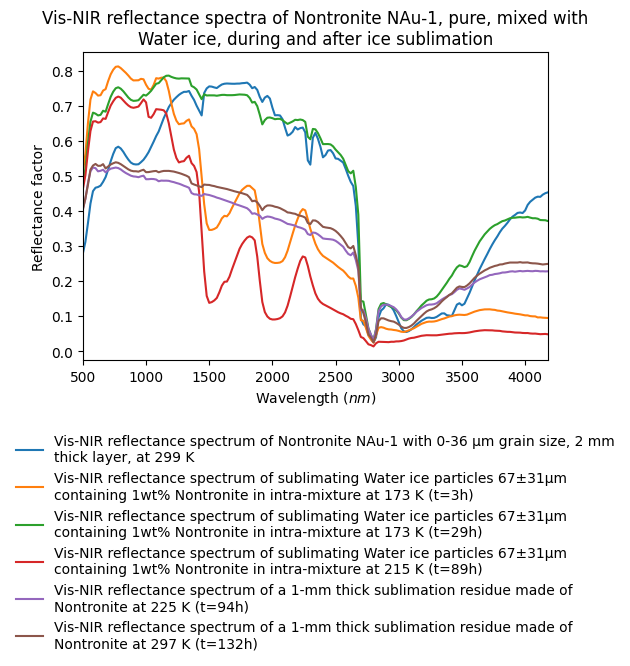- Title
- Vis-NIR reflectance spectra of Nontronite NAu-1, pure, mixed with Water ice, during and after ice sublimation
- DOI
- 10.26302/SSHADE/EXPERIMENT_OP_20200701_001
- Data reference
- Schroeder, Stefan; Poch, Olivier; Ferrari, Marco; DeAngelis, Simone (2019): Vis-NIR reflectance spectra of Nontronite NAu-1, pure, mixed with Water ice, during and after ice sublimation. SSHADE/CSS (OSUG Data Center). Dataset/Spectral Data. https://doi.org/10.26302/SSHADE/EXPERIMENT_OP_20200701_001
- Publications
- Database(s)
- Experimentalists
- Type(s)
- laboratory measurement
- Description
- We measured the reflectance spectra (from 0.5 to 4 µm) of the Nontronite NAu-1 pure (at 300-333 K, under high vacuum) and mixed inside water ice particles (1wt%, at 173 K), as well as during and after sublimation of the water ice under high vacuum (at 173 K). The spectrum of the porous surface of Nontronite obtained after sublimation exhibits a blue spectral slope.
- Number of spectra
- 25
- Variable type(s)
-
- sample composition
- sample abundance
- constituent
- Instrument
- SHINE Spectro-Gonio bidirectional reflection Vis-NIR
- Sample holder
- Aluminum sample holder, closed by a sapphire window and cooled by a He cryostat in a vacuum chamber (Carbo-NIR)
- Standard medium
- vacuum
- Observation mode
- spectrum
- Spectral range type(s)
- Vis, NIR
- Valid spectral range(s)
-
Min - Max ($nm$) Sampling ($nm$) Resolution ($nm$) Position accuracy ($nm$) Absorption edge #1 500.0 - 660.0 20.0 3.2 #2 680.0 - 1380.0 20.0 6.3 #3 1400.0 - 2980.0 20.0 13.0 #4 3000.0 - 4180.0 20.0 26.0 - Filters
-
Type Center/Edge ($nm$) Width ($nm$) Place #1 long-pass filters of the spectro-gonio radiometer
Definition: incidence and emergence angles are positive with origin at nadir, and vary in same direction. Azimuth origin (increasing clockwise) is for i = e (opposition geometry).
- Observation geometry
- bidirectional
- Observation mode
- fixed angles
- Incidence angle
- 0.0°
- Emergence angle
- 30.0°
- Azimuth angle
- 0.0°
- Phase angle
- 30.0°
- Resolution observation
- 4.1°
- Comments
- The spectro-radio-goniometer SHINE was used in Gognito mode, as described in Potin et al. (2018, https://doi.org/10.1364/AO.57.008279), section D.2. The illumination beam was focused on an area of 6 mm in diameter on the sample, in order to increase the signal-to-noise ratio of our measurements.
Illumination
Observation
- Comments
- partial polarization variable with wavelength (from monochromator grating)
- Observation mode
- single spot
- Spatial resolution
- 6.0 $mm$
- Instrument
- SHADOWS Spectro-Gonio bidirectional reflection Vis-NIR
- Sample holder
- Sample holder coated with black aluminum tape, in MIRAGE vacuum chamber closed with a sapphire window.
- Standard medium
- vacuum
- Observation mode
- spectrum
- Spectral range type(s)
- Vis, NIR
- Valid spectral range(s)
-
Min - Max ($nm$) Sampling ($nm$) Resolution ($nm$) Position accuracy ($nm$) Absorption edge #1 500.0 - 660.0 20.0 3.2 #2 680.0 - 1380.0 20.0 6.3 #3 1400.0 - 2980.0 20.0 13.0 #4 3000.0 - 4180.0 20.0 26.0 - Filters
-
Type Center/Edge ($nm$) Width ($nm$) Place #1 long-pass filters of the spectro-gonio radiometer
Definition: incidence and emergence angles are positive with origin at nadir, and vary in same direction. Azimuth origin (increasing clockwise) is for i = e (opposition geometry).
- Observation geometry
- bidirectional
- Observation mode
- fixed angles
- Incidence angle
- 0.0°
- Emergence angle
- 30.0°
- Azimuth angle
- 0.0°
- Phase angle
- 30.0°
- Resolution observation
- 4.1°
Illumination
Observation
- Comments
- partial polarization variable with wavelength (from monochromator grating)
- Observation mode
- single spot
- Spatial resolution
- 5.2 $mm$
- Date begin - end
- 2019-04-16 - 2019-04-25
Versions
- Release date
- 2020-11-02 13:13:35+0000 UTC
- Version (Date)
- #1 (2020-11-02 13:13:35+0000 UTC, Updated: 2020-11-02 13:49:29+0000 UTC)
